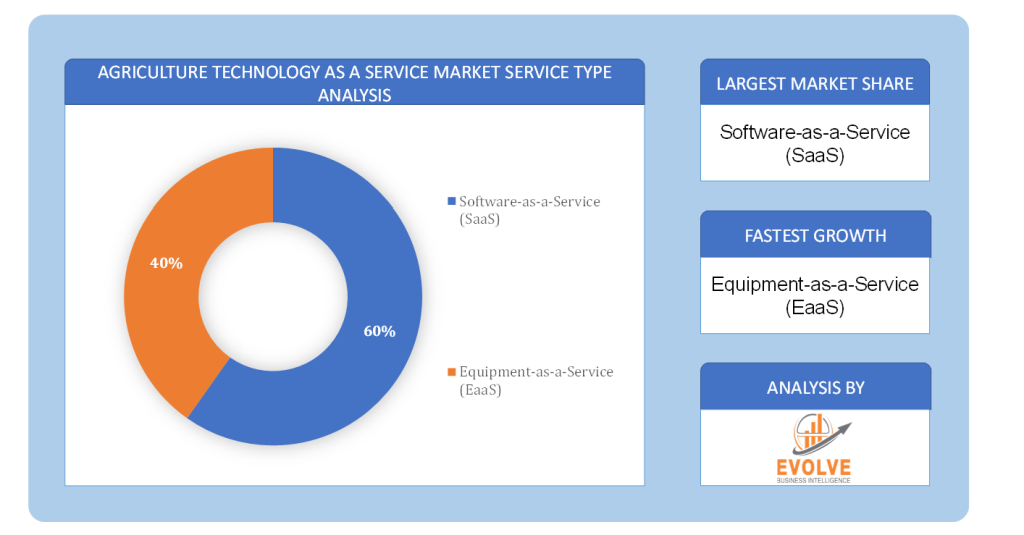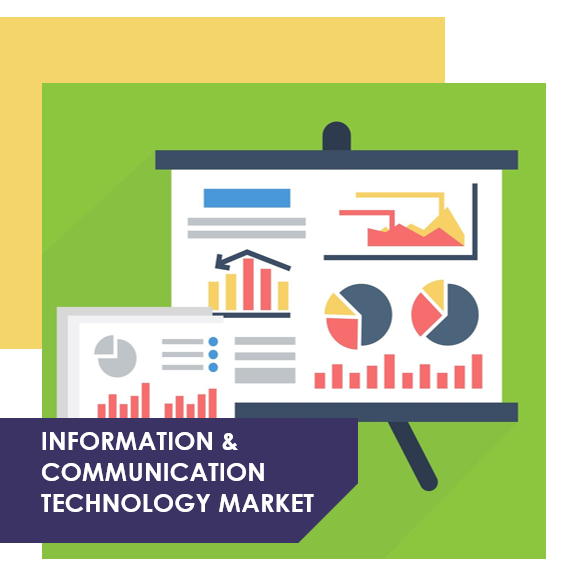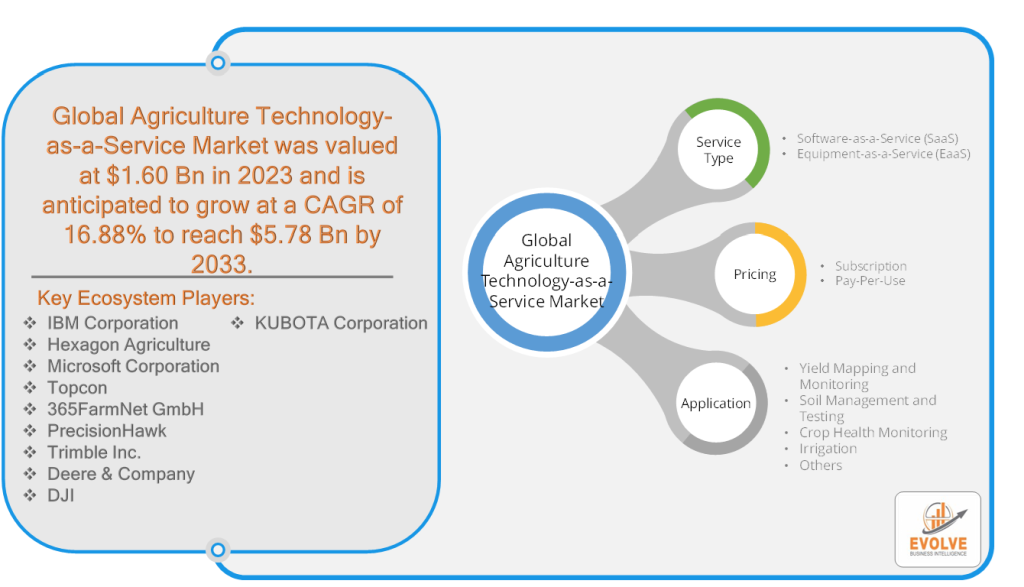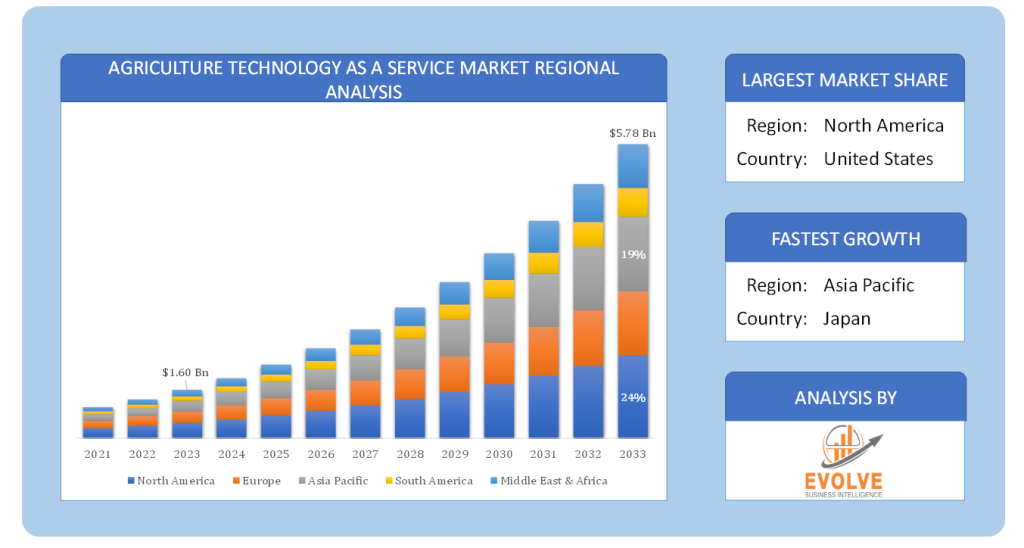Agriculture Technology-as-a-Service Market Analysis and Global Forecast 2023-2033
$ 1,390.00 – $ 5,520.00Price range: $ 1,390.00 through $ 5,520.00
Agriculture Technology-as-a-Service Market Research Report: By Service Type (Software-as-a-Service (SaaS), Equipment-as-a-Service (EaaS), By Pricing (Subscription, Pay-Per-Use), By Application (Yield Mapping and Monitoring, Soil Management and Testing, Crop Health Monitoring, Irrigation, Others), and by Region — Forecast till 2033
Agriculture Technology-as-a-Service Market Overview
The Agriculture Technology-as-a-Service Market Size is expected to reach USD 5.78 Billion by 2033. The Agriculture Technology-as-a-Service industry size accounted for USD 1.60 Billion in 2023 and is expected to expand at a compound annual growth rate (CAGR) of 16.88% from 2023 to 2033. “Agriculture Technology-as-a-Service” (Agri-TaaS) refers to a business model and service delivery approach in the agricultural industry, where advanced technological solutions and tools are provided to farmers and agricultural stakeholders as a service. Agri-TaaS enables farmers to access and utilize cutting-edge agricultural technologies, such as precision farming, smart sensors, data analytics, and remote monitoring, without the need for large upfront investments in hardware, software, or infrastructure. Under the Agri-TaaS model, agricultural technology providers offer a range of services, including hardware installation, software platforms, data collection and analysis, and ongoing technical support. These services are typically delivered on a subscription or pay-per-use basis, allowing farmers to leverage the latest technologies and expertise without the financial burden and complexities of ownership and maintenance.
Global Agriculture Technology-as-a-Service Market Synopsis
 Global Agriculture Technology-as-a-Service Market Dynamics
Global Agriculture Technology-as-a-Service Market Dynamics
The major factors that have impacted the growth of Agriculture Technology-as-a-Service are as follows:
Drivers:
⮚ The increasing adoption of technology in agriculture
One driver of the Agriculture Technology-as-a-Service (AgriTaaS) market is the increasing adoption of technology in agriculture. With the growing global population and the need to feed a larger number of people, farmers, and agricultural businesses are turning to technology to improve efficiency, productivity, and sustainability. AgriTaaS offers farmers access to advanced agricultural technologies without the need for high upfront investments, making it an attractive option for small and medium-sized farmers. The driver here is the demand for technology-driven solutions in agriculture.
Restraint:
- The lack of awareness and understanding among farmers
A potential restraint for the AgriTaaS market is the lack of awareness and understanding among farmers about the benefits and potential of technology. Many traditional farmers may be hesitant to adopt new technologies due to factors such as cost concerns, limited technical knowledge, and resistance to change. Additionally, in certain regions, there may be limited access to reliable internet connectivity and infrastructure, which can hinder the widespread adoption of AgriTaaS solutions. Overcoming these barriers and educating farmers about the value proposition of AgriTaaS will be crucial to drive market growth.
Opportunity:
⮚ The increasing need for sustainable agriculture practices
An opportunity for the AgriTaaS market lies in the increasing need for sustainable agriculture practices. As consumers and regulatory bodies prioritize sustainable and environmentally friendly practices, there is a growing demand for technologies that enable precision agriculture, resource optimization, and reduced environmental impact. AgriTaaS can provide access to these technologies, allowing farmers to implement sustainable practices without significant upfront investments. By leveraging this opportunity, AgriTaaS providers can cater to the evolving needs of the agriculture industry and contribute to a more sustainable and efficient food production system.
Agriculture Technology-as-a-Service Market Segment Overview
By Service Type
 Based on the Service Type, the market is segmented based on Software-as-a-Service (SaaS), and Equipment-as-a-Service (EaaS). The Software-as-a-Service (SaaS) segment was projected to hold the largest market share in the Agriculture Technology-as-a-Service market. SaaS models offer cost advantages as farmers can access and utilize advanced agricultural software without incurring high upfront costs for software licenses or hardware infrastructure. Instead, they pay a subscription fee, making it more affordable for small and medium-sized farmers.
Based on the Service Type, the market is segmented based on Software-as-a-Service (SaaS), and Equipment-as-a-Service (EaaS). The Software-as-a-Service (SaaS) segment was projected to hold the largest market share in the Agriculture Technology-as-a-Service market. SaaS models offer cost advantages as farmers can access and utilize advanced agricultural software without incurring high upfront costs for software licenses or hardware infrastructure. Instead, they pay a subscription fee, making it more affordable for small and medium-sized farmers.
By Pricing
Based on Pricing, the market has been divided into Subscription, Pay-Per-Use. The Subscription segment is expected to hold the largest market share in the Market. This dominance is driven by several factors such as the flexibility and affordability of subscription-based models, continuous updates and support provided to farmers, scalability options, integrated solutions that offer comprehensive tools and services, and the predictability of cost structures. By offering farmers access to a wide range of agricultural technologies and services through recurring subscriptions, the Subscription segment caters to the evolving needs of farmers while enabling them to efficiently manage their operations, optimize productivity, and make data-driven decisions.
By Application
Based on Application, the market has been divided into Yield Mapping and Monitoring, Soil Management and Testing, Crop Health Monitoring, Irrigation, and Others. The Yield Mapping and Monitoring segment is projected to experience significant growth in the Agriculture Technology-as-a-Service market. This growth can be attributed to the increasing demand for precise and real-time data on crop yields and performance. Yield mapping and monitoring technologies provide farmers with valuable insights into field variability, enabling them to optimize resource allocation, identify areas for improvement, and make informed decisions for maximizing crop productivity. By offering these technologies as a service, AgriTaaS providers allow farmers to access advanced yield mapping and monitoring tools without the need for significant upfront investments, making it a cost-effective and accessible solution for farmers of all scales.
Global Agriculture Technology-as-a-Service Market Regional Analysis
Based on region, the market has been divided into North America, Europe, Asia-Pacific, the Middle East & Africa, and Latin America. The area of North America is anticipated to dominate the market for the usage of Agriculture Technology-as-a-Service, followed by those in Asia-Pacific and Europe.
 North America Market
North America Market
North America has historically dominated the market share in the Agriculture Technology-as-a-Service (AgriTaaS) market. This dominance can be attributed to several factors, including the region’s advanced agricultural infrastructure, large-scale commercial farming operations, and early adoption of technology in agriculture. North America has a strong focus on precision farming practices, sustainability, and maximizing crop yields, which has driven the demand for AgriTaaS solutions. Additionally, the presence of well-established AgriTaaS providers, favorable government initiatives, and a supportive regulatory environment have contributed to the growth of the AgriTaaS market in North America. However, it’s important to note that market dynamics can evolve, and other regions may experience accelerated growth as AgriTaaS adoption expands globally.
Asia Pacific Market
The Agriculture Technology-as-a-Service (AgriTaaS) industry in the Asia-Pacific region has been experiencing remarkable growth. This growth can be attributed to several factors, including the region’s large and diverse agricultural sector, increasing adoption of technology in farming practices, and the need to improve productivity and sustainability in agriculture. The Asia-Pacific region is home to a significant number of smallholder farmers, and AgriTaaS provides them with access to advanced agricultural technologies without high upfront costs. Additionally, governments in the region are implementing initiatives to promote digital agriculture and provide support for AgriTaaS adoption. The rising awareness about the benefits of AgriTaaS, coupled with favorable market conditions and technological advancements, has fueled the remarkable growth of the industry in the Asia-Pacific region.
Competitive Landscape
The competitive landscape includes key players (tier 1, tier 2, and local) having a presence across the globe. Companies such as IBM Corporation, Hexagon Agriculture, Microsoft Corporation, and Topcon are some of the leading players in the global 5G in the Healthcare Industry. These players have adopted partnership, acquisition, expansion, and new product development, among others as their key strategies.
Key Market Players:
- IBM Corporation
- Hexagon Agriculture
- Microsoft Corporation
- Topcon
- 365FarmNet GmbH
- PrecisionHawk
- Trimble Inc.
- Deere & Company
- DJI
- KUBOTA Corporation
Key development:
In November 2022, Small Robot Company achieved a significant milestone with the launch of their latest monitoring robot, known as Tom v4. This product marks a major advancement for both farmers and corporations. Tom v4 stands out with its exceptional resolution of 0.28mm per pixel, making it one of the most high-resolution crop-scanning technologies available. This remarkable capability enables Tom to identify early indicators of disease outbreaks and even detect individual water droplets on leaves, providing valuable insights for precision agriculture and proactive plant health management.
Scope of the Report
Global Agriculture Technology-as-a-Service Market, by Service Type
- Software-as-a-Service (SaaS)
- Equipment-as-a-Service (EaaS)
Global Agriculture Technology-as-a-Service Market, by Pricing
- Subscription
- Pay-Per-Use
Global Agriculture Technology-as-a-Service Market, by Application
- Yield Mapping and Monitoring
- Soil Management and Testing
- Crop Health Monitoring
- Irrigation
- Others
Global Agriculture Technology-as-a-Service Market, by Region
- North America
- US
- Canada
- Mexico
- Europe
- UK
- Germany
- France
- Italy
- Spain
- Benelux
- Nordic
- Rest of Europe
- Asia Pacific
- China
- Japan
- South Korea
- Indonesia
- Austalia
- Malaysia
- India
- Rest of Asia Pacific
- South America
- Brazil
- Argentina
- Rest of South America
- Middle East & Africa
- Saudi Arabia
- UAE
- Egypt
- South Africa
- Rest of Middle East & Africa
| Parameters | Indicators |
|---|---|
| Market Size | 2033: $5.78 Billion |
| CAGR | 16.88% CAGR (2023-2033) |
| Base year | 2022 |
| Forecast Period | 2023-2033 |
| Historical Data | 2021 |
| Report Coverage | Revenue Forecast, Competitive Landscape, Growth Factors, and Trends |
| Key Segmentations | Service Type, Pricing, Application |
| Geographies Covered | North America, Europe, Asia-Pacific, Latin America, Middle East, Africa |
| Key Vendors | IBM Corporation, Hexagon Agriculture, Microsoft Corporation, Topcon, 365FarmNet GmbH, PrecisionHawk, Trimble Inc, Deere & Company, DJI, KUBOTA Corporation |
| Key Market Opportunities | • Growing demand for sustainable agriculture practices • Rising need for precision agriculture and resource optimization • Integration of various agricultural systems and data sources for better decision-making |
| Key Market Drivers | • Increasing adoption of technology in agriculture • Need for improved efficiency, productivity, and sustainability in farming • Cost advantages of accessing advanced agricultural technologies through AgriTaaS models |
REPORT CONTENT BRIEF:
- High-level analysis of the current and future Agriculture Technology-as-a-Service Industry trends and opportunities
- Detailed analysis of current market drivers, restraining factors, and opportunities analysis in the future
- Historical market size for the year 2021, and forecast from 2023 to 2033
- Agriculture Technology-as-a-Service market share analysis for each segment
- Competitor analysis with a comprehensive insight into its product segment, financial strength, and strategies adopted.
- Identifies key strategies adopted by the key players including new product development, mergers and acquisitions, joint ventures, collaborations, and partnerships.
- To identify and understand the various factors involved in the global Agriculture Technology-as-a-Service market affected by the pandemic
- To provide year-on-year growth from 2022 to 2033
- To provide short-term, long-term, and overall CAGR comparison from 2022 to 2033.
- Provide Total Addressable Market (TAM) for the Global Agriculture Technology-as-a-Service Market.
Frequently Asked Questions (FAQ)
The study period of the global Agriculture Technology-as-a-Service market is 2022- 2033
The global Agriculture Technology-as-a-Service market is growing at a CAGR of ~88% over the next 10 years
Asia Pacific is expected to register the highest CAGR during 2023-2033
North America holds the largest share in 2022
IBM Corporation, Hexagon Agriculture, Microsoft Corporation, Topcon, 365FarmNet GmbH, PrecisionHawk, Trimble Inc, Deere & Company, DJI, and KUBOTA Corporation are the major companies operating in the Agriculture Technology-as-a-Service
Yes, we offer 16 hours of analyst support to solve the queries
Yes, we do provide regional as well as country-level reports. Other than this we also provide a sectional report. Please get in contact with our sales representatives.
Press Release

Global Pharmaceutical Manufacturing Market to Reach $1.38 Trillion by 2035 with 7.35% CAGR, New Research Shows

The Global Mammography Market Is Estimated To Record a CAGR of Around 10.29% During The Forecast Period

Glue Stick Market to Reach USD 2.35 Billion by 2034

Podiatry Service Market to Reach USD 11.88 Billion by 2034

Microfluidics Technology Market to Reach USD 32.58 Billion by 2034

Ferric Chloride Market to Reach USD 10.65 Billion by 2034

Family Practice EMR Software Market to Reach USD 21.52 Billion by 2034

Electric Hairbrush Market to Reach USD 15.95 Billion by 2034

Daily Bamboo Products Market to Reach USD 143.52 Billion by 2034

Cross-border E-commerce Logistics Market to Reach USD 112.65 Billion by 2034
Table of Content
CHAPTER 1. Executive Summary CHAPTER 2. Scope of the Study 2.1. Market Definition 2.2. Market Scope & Segmentation 2.2.1. Objective of Report CHAPTER 3. Evolve BI Methodology 3.1. Data Collection & Validation Approach 3.2. Market Size Estimation and Forecast CHAPTER 4. Exclusive Analysis 4.1. Market Opportunity Score 4.1.1. Service Type Segement – Market Opportunity Score 4.1.2. Pricing Segment – Market Opportunity Score 4.1.3. Application Segment – Market Opportunity Score 4.2. Key Market Influencing Indicators CHAPTER 5. Market Insights and Trends 5.1. Value Chain Analysis 5.1.1. Raw Material 5.1.2. Manufacturing Process 5.1.3. Distribution Channel 5.1.4. End User 5.2. Porter’s Five Forces Analysis 5.2.1. Bargaining Power of Buyers 5.2.2. Bargaining Power of Suppliers 5.2.3. Threat of New Entrant 5.2.4. Threat of Substitute 5.2.5. Industry Rivalry 5.3. COVID-19 Impact and Post COVID Scenario on Agriculture Technology-as-a-Service Market 5.3.1. Impact of COVID-19 5.3.2. Government Support and Industry Revival Policies 5.3.3. Measures Taken by Companies to Mitigate Negative Impact 5.3.4. Post COVID Trend CHAPTER 6. MArket Dynamics 6.1. Introduction 6.2. Drivers 6.2.1. Driver 1 6.2.2. Driver 2 6.2.3. Driver 3 6.3. Restraints 6.3.1. Restraint 1 6.3.2. Restraint 2 6.4. Opportunity 6.4.1. Opportunity 1 CHAPTER 7. Global Agriculture Technology-as-a-Service Market, By Service Type 7.1. Introduction 7.1.1. Software-as-a-Service (SaaS) 7.1.2. Equipment-as-a-Service (EaaS) CHAPTER 8. Global Agriculture Technology-as-a-Service Market, By Pricing 8.1. Introduction 8.1.1. Subscription 8.1.2. Pay-Per-Use CHAPTER 9. Global Agriculture Technology-as-a-Service Market, By Application 9.1. Introduction 9.1.1. Yield Mapping and Monitoring 9.1.2. Soil Management and Testing 9.1.3. Crop Health Monitoring 9.1.4. Irrigation 9.1.5. Others CHAPTER 10. Global Agriculture Technology-as-a-Service Market, By Region 10.1. Introduction 10.2. NORTH AMERICA 10.2.1. North America: Market Size and Forecast, By Country, 2023 – 2033 ($ Million) 10.2.2. North America: Market Size and Forecast, By Service Type, 2023 – 2033 ($ Million) 10.2.3. North America: Market Size and Forecast, By Pricing, 2023 – 2033 ($ Million) 10.2.4. North America: Market Size and Forecast, By Application, 2023 – 2033 ($ Million) 10.2.5. US 10.2.5.1. US: Market Size and Forecast, By Service Type, 2023 – 2033 ($ Million) 10.2.5.2. US: Market Size and Forecast, By Pricing, 2023 – 2033 ($ Million) 10.2.5.3. US: Market Size and Forecast, By Application, 2023 – 2033 ($ Million) 10.2.6. CANADA 10.2.6.1. Canada: Market Size and Forecast, By Service Type, 2023 – 2033 ($ Million) 10.2.6.2. Canada: Market Size and Forecast, By Pricing, 2023 – 2033 ($ Million) 10.2.6.3. Canada: Market Size and Forecast, By Application, 2023 – 2033 ($ Million) 10.2.7. MEXICO 10.2.7.1. Mexico: Market Size and Forecast, By Service Type, 2023 – 2033 ($ Million) 10.2.7.2. Mexico: Market Size and Forecast, By Pricing, 2023 – 2033 ($ Million) 10.2.7.3. Mexico: Market Size and Forecast, By Application, 2023 – 2033 ($ Million) 10.3. Europe 10.3.1. Europe: Market Size and Forecast, By Country, 2023 – 2033 ($ Million) 10.3.2. Europe: Market Size and Forecast, By Service Type, 2023 – 2033 ($ Million) 10.3.3. Europe: Market Size and Forecast, By Pricing, 2023 – 2033 ($ Million) 10.3.4. Europe: Market Size and Forecast, By Application, 2023 – 2033 ($ Million) 10.3.5. U.K. 10.3.5.1. U.K.: Market Size and Forecast, By Service Type, 2023 – 2033 ($ Million) 10.3.5.2. U.K.: Market Size and Forecast, By Pricing, 2023 – 2033 ($ Million) 10.3.5.3. U.K.: Market Size and Forecast, By Application, 2023 – 2033 ($ Million) 10.3.6. GERMANY 10.3.6.1. Germany: Market Size and Forecast, By Service Type, 2023 – 2033 ($ Million) 10.3.6.2. Germany: Market Size and Forecast, By Pricing, 2023 – 2033 ($ Million) 10.3.6.3. Germany: Market Size and Forecast, By Application, 2023 – 2033 ($ Million) 10.3.7. FRANCE 10.3.7.1. France: Market Size and Forecast, By Service Type, 2023 – 2033 ($ Million) 10.3.7.2. France: Market Size and Forecast, By Pricing, 2023 – 2033 ($ Million) 10.3.7.3. France: Market Size and Forecast, By Application, 2023 – 2033 ($ Million) 10.3.8. ITALY 10.3.8.1. Italy: Market Size and Forecast, By Service Type, 2023 – 2033 ($ Million) 10.3.8.2. Italy: Market Size and Forecast, By Pricing, 2023 – 2033 ($ Million) 10.3.8.3. Italy: Market Size and Forecast, By Application, 2023 – 2033 ($ Million) 10.3.9. SPAIN 10.3.9.1. Spain: Market Size and Forecast, By Service Type, 2023 – 2033 ($ Million) 10.3.9.2. Spain: Market Size and Forecast, By Pricing, 2023 – 2033 ($ Million) 10.3.9.3. Spain: Market Size and Forecast, By Application, 2023 – 2033 ($ Million) 10.3.10. BENELUX 10.3.10.1. BeNeLux: Market Size and Forecast, By Service Type, 2023 – 2033 ($ Million) 10.3.10.2. BeNeLux: Market Size and Forecast, By Pricing, 2023 – 2033 ($ Million) 10.3.10.3. BeNeLux: Market Size and Forecast, By Application, 2023 – 2033 ($ Million) 10.3.11. RUSSIA 10.3.11.1. Russia: Market Size and Forecast, By Service Type, 2023 – 2033 ($ Million) 10.3.11.2. Russia: Market Size and Forecast, By Pricing, 2023 – 2033 ($ Million) 10.3.11.3. Russia: Market Size and Forecast, By Application, 2023 – 2033 ($ Million) 10.3.12. REST OF EUROPE 10.3.12.1. Rest of Europe: Market Size and Forecast, By Service Type, 2023 – 2033 ($ Million) 10.3.12.2. Rest of Europe: Market Size and Forecast, By Pricing, 2023 – 2033 ($ Million) 10.3.12.3. Rest of Europe: Market Size and Forecast, By Application, 2023 – 2033 ($ Million) 10.4. Asia Pacific 10.4.1. Asia Pacific: Market Size and Forecast, By Country, 2023 – 2033 ($ Million) 10.4.2. Asia Pacific: Market Size and Forecast, By Service Type, 2023 – 2033 ($ Million) 10.4.3. Asia Pacific: Market Size and Forecast, By Pricing, 2023 – 2033 ($ Million) 10.4.4. Asia Pacific: Market Size and Forecast, By Application, 2023 – 2033 ($ Million) 10.4.5. CHINA 10.4.5.1. China: Market Size and Forecast, By Service Type, 2023 – 2033 ($ Million) 10.4.5.2. China: Market Size and Forecast, By Pricing, 2023 – 2033 ($ Million) 10.4.5.3. China: Market Size and Forecast, By Application, 2023 – 2033 ($ Million) 10.4.6. JAPAN 10.4.6.1. Japan: Market Size and Forecast, By Service Type, 2023 – 2033 ($ Million) 10.4.6.2. Japan: Market Size and Forecast, By Pricing, 2023 – 2033 ($ Million) 10.4.6.3. Japan: Market Size and Forecast, By Application, 2023 – 2033 ($ Million) 10.4.7. INDIA 10.4.7.1. India: Market Size and Forecast, By Service Type, 2023 – 2033 ($ Million) 10.4.7.2. India: Market Size and Forecast, By Pricing, 2023 – 2033 ($ Million) 10.4.7.3. India: Market Size and Forecast, By Application, 2023 – 2033 ($ Million) 10.4.8. SOUTH KOREA 10.4.8.1. South Korea: Market Size and Forecast, By Service Type, 2023 – 2033 ($ Million) 10.4.8.2. South Korea: Market Size and Forecast, By Pricing, 2023 – 2033 ($ Million) 10.4.8.3. South Korea: Market Size and Forecast, By Application, 2023 – 2033 ($ Million) 10.4.9. THAILAND 10.4.9.1. Thailand: Market Size and Forecast, By Service Type, 2023 – 2033 ($ Million) 10.4.9.2. Thailand: Market Size and Forecast, By Pricing, 2023 – 2033 ($ Million) 10.4.9.3. Thailand: Market Size and Forecast, By Application, 2023 – 2033 ($ Million) 10.4.10. INDONESIA 10.4.10.1. Indonesia: Market Size and Forecast, By Service Type, 2023 – 2033 ($ Million) 10.4.10.2. Indonesia: Market Size and Forecast, By Pricing, 2023 – 2033 ($ Million) 10.4.10.3. Indonesia: Market Size and Forecast, By Application, 2023 – 2033 ($ Million) 10.4.11. MALAYSIA 10.4.11.1. Malaysia: Market Size and Forecast, By Service Type, 2023 – 2033 ($ Million) 10.4.11.2. Malaysia: Market Size and Forecast, By Pricing, 2023 – 2033 ($ Million) 10.4.11.3. Malaysia: Market Size and Forecast, By Application, 2023 – 2033 ($ Million) 10.4.12. AUSTRALIA 10.4.12.1. Australia: Market Size and Forecast, By Service Type, 2023 – 2033 ($ Million) 10.4.12.2. Australia: Market Size and Forecast, By Pricing, 2023 – 2033 ($ Million) 10.4.12.3. Australia: Market Size and Forecast, By Application, 2023 – 2033 ($ Million) 10.4.13. REST FO ASIA PACIFIC 10.4.13.1. Rest fo Asia Pacific: Market Size and Forecast, By Service Type, 2023 – 2033 ($ Million) 10.4.13.2. Rest fo Asia Pacific: Market Size and Forecast, By Pricing, 2023 – 2033 ($ Million) 10.4.13.3. Rest fo Asia Pacific: Market Size and Forecast, By Application, 2023 – 2033 ($ Million) 10.5. South America 10.5.1. South America: Market Size and Forecast, By Country, 2023 – 2033 ($ Million) 10.5.2. South America: Market Size and Forecast, By Service Type, 2023 – 2033 ($ Million) 10.5.3. South America: Market Size and Forecast, By Pricing, 2023 – 2033 ($ Million) 10.5.4. South America: Market Size and Forecast, By Application, 2023 – 2033 ($ Million) 10.5.5. BRAZIL 10.5.5.1. Brazil: Market Size and Forecast, By Service Type, 2023 – 2033 ($ Million) 10.5.5.2. Brazil: Market Size and Forecast, By Pricing, 2023 – 2033 ($ Million) 10.5.5.3. Brazil: Market Size and Forecast, By Application, 2023 – 2033 ($ Million) 10.5.6. ARGENTINA 10.5.6.1. Argentina: Market Size and Forecast, By Service Type, 2023 – 2033 ($ Million) 10.5.6.2. Argentina: Market Size and Forecast, By Pricing, 2023 – 2033 ($ Million) 10.5.6.3. Argentina: Market Size and Forecast, By Application, 2023 – 2033 ($ Million) 10.5.7. REST OF SOUTH AMERICA 10.5.7.1. Rest of South America: Market Size and Forecast, By Service Type, 2023 – 2033 ($ Million) 10.5.7.2. Rest of South America: Market Size and Forecast, By Pricing, 2023 – 2033 ($ Million) 10.5.7.3. Rest of South America: Market Size and Forecast, By Application, 2023 – 2033 ($ Million) 10.6. Middle East & Africa 10.6.1. Middle East & Africa: Market Size and Forecast, By Country, 2023 – 2033 ($ Million) 10.6.2. Middle East & Africa: Market Size and Forecast, By Service Type, 2023 – 2033 ($ Million) 10.6.3. Middle East & Africa: Market Size and Forecast, By Pricing, 2023 – 2033 ($ Million) 10.6.4. Middle East & Africa: Market Size and Forecast, By Application, 2023 – 2033 ($ Million) 10.6.5. SAUDI ARABIA 10.6.5.1. Saudi Arabia: Market Size and Forecast, By Service Type, 2023 – 2033 ($ Million) 10.6.5.2. Saudi Arabia: Market Size and Forecast, By Pricing, 2023 – 2033 ($ Million) 10.6.5.3. Saudi Arabia: Market Size and Forecast, By Application, 2023 – 2033 ($ Million) 10.6.6. UAE 10.6.6.1. UAE: Market Size and Forecast, By Service Type, 2023 – 2033 ($ Million) 10.6.6.2. UAE: Market Size and Forecast, By Pricing, 2023 – 2033 ($ Million) 10.6.6.3. UAE: Market Size and Forecast, By Application, 2023 – 2033 ($ Million) 10.6.7. EGYPT 10.6.7.1. Egypt: Market Size and Forecast, By Service Type, 2023 – 2033 ($ Million) 10.6.7.2. Egypt: Market Size and Forecast, By Pricing, 2023 – 2033 ($ Million) 10.6.7.3. Egypt: Market Size and Forecast, By Application, 2023 – 2033 ($ Million) 10.6.8. SOUTH AFRICA 10.6.8.1. South Africa: Market Size and Forecast, By Service Type, 2023 – 2033 ($ Million) 10.6.8.2. South Africa: Market Size and Forecast, By Pricing, 2023 – 2033 ($ Million) 10.6.8.3. South Africa: Market Size and Forecast, By Application, 2023 – 2033 ($ Million) 10.6.9. REST OF MIDDLE EAST & AFRICA 10.6.9.1. Rest of Middle East & Africa: Market Size and Forecast, By Service Type, 2023 – 2033 ($ Million) 10.6.9.2. Rest of Middle East & Africa: Market Size and Forecast, By Pricing, 2023 – 2033 ($ Million) 10.6.9.3. Rest of Middle East & Africa: Market Size and Forecast, By Application, 2023 – 2033 ($ Million) CHAPTER 12. Competitive Landscape 12.1. Competitior Benchmarking 2023 12.2. Market Share Analysis 12.3. Key Developments Analysis By Top 5 Companies 12.4. Market Share Acquisition Strategies: Analysis of Key Approaches Employed by Top Players CHAPTER 13. Company Profiles 13.1. IBM Corporation 13.1.1. Business Overview 13.1.2. Financial Analysis 13.1.2.1. Business Segment Revenue, 2020, 2021, 2022, $ Million 13.1.2.2. Geographic Revenue Mix, 2022 (% Share) 13.1.3. Product Portfolio 13.1.4. Recent Development and Strategies Adopted 13.1.5. SWOT Analysis 13.2. Hexagon Agriculture 13.3. Microsoft Corporation 13.4. Topcon 13.5. 365FarmNet GmbH 13.6. PrecisionHawk 13.7. Trimble Inc. 13.8. Deere & Company 13.9. DJI 13.10. KUBOTA Corporation
Connect to Analyst
Research Methodology









